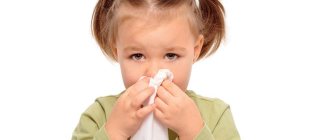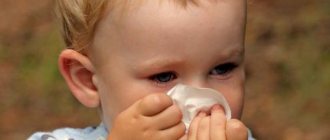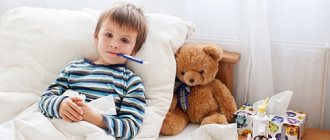Author's rating
Author of the article
Green Elena Stanislavovna
Otolaryngologist of the second category
Articles written
665
about the author
A severe cough symptom in children may indicate dangerous damage to the tissues of the larynx. With such a deviation, a gap and swelling occurs between the vocal folds. This symptom is usually called croup; it is caused by hoarseness in the voice, rough coughing and shortness of breath. The baby may choke with this cough symptom, in such cases medical attention will be necessary. You should pay attention to the form of cough in a child.
In a child, treatment should always be agreed upon with a doctor, especially when the cause is a bacterial infection, asthma or other serious illnesses. Why a child has a hard cough and what its treatment will be will be determined only by a specialist.
Dry cough in children: causes
Possible causes of the disease
Experts call a dry cough a cough that does not produce sputum or mucus. This cough can be very strong and painful for the child.
Treatment of such a pathology is prescribed taking into account the reason that caused its development.
Most often, a dry cough begins to bother a child for the following reasons:
- One of the common causes of dry cough in childhood is a cold. As it develops, a viral infection enters the baby’s body, which has a pathological effect on the respiratory system. The initial symptoms of the development of the disease are the appearance of soreness and slight irritation in the throat, which subsequently causes a cough. The progression of the pathology leads to the fact that the cough can become wet as a result of the appearance of sputum, which is produced by the body. After some time, when the disease subsides, the child may have a dry cough again. The reason for this phenomenon is a decrease in the amount of mucus produced by the child’s body.
- Another reason for the development of a dry cough can be the influenza virus, the symptoms of which resemble a cold. However, a child's condition with the flu is much worse than with a cold. The disease can begin with the appearance of a dry cough, which can gradually turn into a wet one.
- The presence of a large number of irritants in the environment can lead to a child developing a dry cough. The body of a small child is too sensitive to the effects of such unfavorable factors as cigarette smoke, chemicals and dry air.
- In some cases, a dry cough may be the result of a pathology such as gastroesophageal reflux disease. The development of such a pathology in the child’s body is accompanied by a rise in stomach acid and stomach contents back through the esophagus. The cause of a dry cough is the fact that stomach acid irritates the throat.
- Sometimes a disease such as whooping cough can cause children to cough without producing sputum. This pathology causes a bacterial infection to penetrate the respiratory system, which leads to a cough with a characteristic buzzing sound. In some cases, the cough becomes so strong that it causes the child to cry and the tongue to stick out.
Symptoms
Dry cough - signs of the disease
A dry cough is often a consequence of the progression of various respiratory diseases in the child’s body. Such a cough has a traumatic effect on the respiratory tract, but does not bring irritants to the surface.
A dry cough is not accompanied by mucus discharge and does not clear the airways, but only air is coughed up.
This disease is usually the result of progression in the child’s body of pathologies such as:
If such a cough continues for several months, then experts talk about its transition to a chronic form.
The following cough should cause concern for parents:
- becomes barking and paroxysmal, and does not go away for a long time
- occurs completely unexpectedly and persists for a very long time
- bothers the child at night and prevents him from sleeping
- provokes bouts of vomiting
- causes a severe allergic reaction
- combined with a rise in body temperature and a deterioration in general condition
A dry cough is most often one of the symptoms of pathology and the main task of the specialist is to find out which one it is.
Dry and raspy cough
A dry cough is a cough in which no mucus or phlegm is produced. The cough reflex is provoked by irritation of the mucous membrane of the respiratory tract.
In addition to removing irritants, coughing also removes mucus. If mucus is produced in negligible quantities, this, accordingly, leads to the development of a dry cough.
If there is little sputum, the cough will be unproductive.
Typically, the cough may begin as a nonproductive cough (dry cough). Over time, it turns into a productive (wet) cough.
Drug therapy
Features of the treatment of dry cough with medications
The main method of treating dry cough in childhood is drug therapy, which includes taking medications. Doctors recommend that children under two years of age be given medicine in the form of syrup, however, in some cases it can provoke the development of an allergic reaction.
It is important to remember that cough is the result of the progression of various diseases in the child’s body and medications only have a suppressive effect for a short time.
All medications that are prescribed to eliminate a child’s illness can be divided into several types:
- Mucolytics are direct-acting expectorants that have a thinning effect on sputum and help the child in expectorating it.
- Secretomotor expectorants mainly consist of herbal tinctures. Their action is based on absorption through the stomach and stimulating an increase in sputum production.
- Antitussive reflex drugs have a suppressive effect on the cough reflex.
Most often, experts recommend that parents treat dry cough in children using the following medications:
- Herbion plantain syrup
- Eofinil
- Ambrobene
- Isla Moos
- Erespal
- Sinekod
If a dry cough is accompanied by an increase in body temperature, then treatment in this case is supplemented by taking antibacterial drugs.
Antibiotics
Antibacterial drugs: types and purpose
The main purpose of prescribing antibacterial drugs is to suppress pathogenic microorganisms that caused the development of pathology.
It is important for parents to understand that taking such drugs causes disruption of the intestinal microflora. It is for this reason that to restore it, doctors recommend giving the child medications that contain probiotics.
Antibacterial drugs are prescribed:
- for acute and chronic bronchitis
- for pneumonia
- for tuberculosis
- with pleurisy
- for tuberculosis
Treatment of dry cough in children can be carried out using the following groups of antibacterial drugs - penicillins, cephalosporins and macrolides.
Penicillins are usually prescribed for drug therapy for dry and wet cough. If taking medications from this group does not bring positive results, they should be discontinued. The main antibiotics of this group are:
Cephalosporins are prescribed to children if they have already received antibacterial treatment some time ago. In addition, antibiotics of this group are used if penicillins do not bring noticeable improvements in the child’s condition. The most effective antibiotics in this group are:
Macrolides are among the most effective drugs that are used to eliminate the inflammatory process in the respiratory system. Treatment of pathologies is carried out using antibacterial drugs such as:
Taking antibacterial drugs in childhood can only be done as prescribed by a specialist, since in some cases they cause side effects.
Types of cough
Many parents know firsthand how difficult it is to get rid of illness, especially in young children. After all, most medications are prohibited for young patients, and folk remedies often cause allergies. Therefore, the selection of treatment methods should be carried out by a pediatrician.
Only a doctor is able to make the correct diagnosis and, depending on the age of the child and the type of cough, prescribe the necessary medicine. But parents also have a significant responsibility. To make it easier to understand the pathological process, let’s look at the main types of cough in children, find out why they are dangerous and talk about treatment methods.
Physiological cough
Any person periodically needs to clear the airways of dust and accumulated phlegm. This is a normal reaction aimed at protecting the body from foreign bodies and pathogenic bacteria.
Thus, a child’s natural cough is not a pathology and does not require treatment. It occurs most often in the morning and does not cause significant discomfort to the baby.
Dry or dusty indoor air can provoke such a reflex. This problem is especially relevant during the heating season.
Pathological cough
Most often, children are bothered by this type of cough. Unlike the natural one, it manifests itself in a very diverse manner and depends on the nature of the pathogen. In most cases, these are various respiratory diseases:
- laryngitis and pharyngitis;
- tracheitis;
- bronchitis;
- pneumonia;
- acute respiratory infections and acute respiratory viral infections;
- acute and chronic tonsillitis;
- flu;
- tuberculosis.
In general, the causes of cough in children are varied and are not always of an infectious nature. A similar reflex can be caused by a narrowing of the bronchi, which is specific to bronchial asthma, or by the entry of a foreign body into the respiratory system. In this case, the cough develops unexpectedly and is choking in nature. The child's voice disappears and breathing becomes difficult.
Causes of cough in children
An ailment of an allergic nature has other symptoms - a cough occurs for no apparent reason and is not accompanied by signs of a cold. After the allergen is removed, the baby's condition returns to normal.
A child may develop a frequent cough due to helminthic infestation. The larvae of some worms parasitize in the lung tissue, causing suffocation and irritating the receptors of the respiratory tract. In other cases, the worms travel up the esophagus and enter the throat, causing an attack.
In different pathological conditions, cough manifests itself differently. It can be productive and dry, barking or harsh, dull, paroxysmal and spastic.
Dry cough
The most obsessive cough in a child. It usually appears at the beginning of the disease and causes many problems for both parents and the baby. It does not separate sputum, so the process of coughing becomes long and painful. If not treated correctly, it becomes chronic.
Spasmodic reflex
If a child coughs against the background of bronchial spasm, it is quite possible to develop asthma. In this case, there is no sputum, the baby suffocates and wheezes. The malaise is paroxysmal in nature and requires mandatory medical supervision.
Croupous cough (false croup)
The most dangerous type of illness, especially for young children. In this category of children, the anatomical and physiological structure of the larynx predisposes them to the development of croup. Even the slightest inflammation can cause severe swelling and suffocation. Therefore, if a child develops a hard, barking cough, it is necessary to consult a doctor.
If your baby develops a barking cough, it is necessary to show him to a doctor.
The following symptoms will help distinguish false croup from other ENT diseases:
- hoarseness, especially after crying;
- swelling of the larynx;
- shortness of breath, severe difficulty breathing;
- pale or blue discoloration of the skin;
- loss of consciousness is possible.
If the child only wheezes, but does not cough and is breathing heavily, these are also signs of incipient false croup.
In this case, you should not engage in amateur activities and try to help the baby with folk remedies. You will only waste precious time. Laryngeal edema is very dangerous and must be treated by a doctor.
Wet (productive) cough
This, one might say, is an ideal scenario for the development of the disease. Such a cough, as a rule, appears at the end of the disease, does not cause alarm and is quickly cured. With its help, the lungs and bronchi are freed from sputum and remnants of pathogenic microorganisms. How to treat a child’s cough of this nature will be discussed below.
Inhalations for cough
Nebulizer for dry cough: benefits and solutions
Today, inhalations are widely used in the treatment of both dry and wet coughs. Thanks to this procedure, it is possible to soften a dry cough, get rid of the pathological process and speed up the recovery process.
Inhalations are one of the most gentle and safe methods of eliminating dry cough in childhood. In addition, this treatment is a good alternative to taking medicines and tablets, which often cause side effects.
Carrying out inhalations using a nebulizer allows medications to penetrate deep into the respiratory organs and eliminate the pathological process.
This is possible thanks to steam molecules, which help enhance the effects of drugs and relieve spasmodic syndrome of the smooth muscles of the respiratory organs.
Inhalations can be performed using:
- ultrasonic
- compression nebulizer
When a child develops a dry cough, the main task is:
- soothing a sore throat
- decreased mucus viscosity
- removal of mucus from the lungs and bronchi
Useful video - Cough in a child.
In childhood, inhalations can be carried out with the addition of the following medications:
You can get rid of the inflammatory process in the respiratory organs with the help of a drug such as Rotokan. If a dry cough is caused by bronchitis of bacterial origin, then inhalations are performed with the addition of:
In order to moisturize the mucous membranes of the respiratory system, experts recommend that children inhale with mineral water or saline, which can be purchased at any pharmacy.
How else to alleviate the condition
If parents do not know how to cure a child’s cough on their own, they can create favorable conditions for recovery:
- The air in the patient's room needs to be humidified if it is too dry. The optimal figure is about 60%.
- Excessively high or low temperatures are also unacceptable; it is better to maintain 20°C, since any deviations from this indicator lead to irritation of the respiratory tract.
- Regular ventilation and wet cleaning - every day.
- Drinking plenty of fluids is necessary to moisturize the mucous membrane.
- Inhalations are done only after approval by a doctor.
- You cannot force a child to eat.
But the main thing is to strictly follow all the doctor’s instructions, because by self-medicating, you can provoke a serious illness, which will be much more difficult to get rid of.
Traditional methods of treatment
Treatment of dry cough in childhood can be carried out both with the help of drug therapy and traditional medicine. In order to achieve a speedy recovery, experts recommend combining medications with traditional treatment at home.
Among the wide variety of traditional medicine recipes, the following are considered the most effective:
- A good result is obtained by taking a medicinal mixture prepared from carrot juice and honey. It is recommended to take this medicine several times a day, 10 ml.
- You can prepare radish with sugar according to the following recipe: cut the root vegetable into small cubes, put them in a container and cover with sugar. After this, place the container in the oven and bake for two hours. The prepared mixture must be strained, the liquid must be poured into a separate bowl, and the radish pieces can be discarded. After this, the resulting medicine must be taken several times a day, 10 ml before meals and before going to bed.
- You can quickly get rid of a cough with the help of figs, which are prepared as follows: several fruits are placed in a glass of milk and boiled until fully cooked. The resulting decoction can be used not only in the treatment of dry cough, but also such pathologies as whooping cough and colds. It is necessary to take a decoction of figs in childhood warm and before bedtime.
- Grind the lemon in a meat grinder and add 10 ml of honey to the resulting mixture. After this, the medicinal mass should be infused for three hours, after which it can be taken 5 ml several times a day.
- Dry cough in young children can be treated with badger fat, which is used for rubbing the body. After this, the child’s body is wrapped warmly and left for a while. In older children, badger fat is given orally, after dissolving it in warm milk and adding a little honey to the resulting mixture.
Before starting to treat your child with traditional medicine recipes, it is recommended to consult a specialist, since some ingredients can trigger the development of an allergic reaction.
Prevention of the disease
To date, there is no single method that would guarantee complete protection against cough.
However, following simple recommendations will reduce the likelihood of developing this pathology. In order to avoid coughing in childhood, it is recommended to follow the following tips:
- Wash your hands as often as possible, which reduces the likelihood of viruses entering the body
- avoid contact with people who cough, especially during an epidemic
- saturate the child’s body with vitamins, especially during the off-season
- ensure the child’s drinking regime, that is, he should consume as much liquid as possible
- carry out hardening activities
- spend more time outdoors
Often a cough is a symptom of a disease that is progressing in the child’s body. It is for this reason that it is important that the child’s treatment is carried out under the supervision of a specialist, which will help avoid the development of many complications.
source
Diagnostics
Diagnosis should only be carried out under the supervision of a doctor.
The problems of this profile are dealt with by otolaryngologists and pulmonologists.
During the initial examination, the doctor asks questions to the patient’s parents and the patient himself to determine the nature of the pathology.
Then instrumental and laboratory diagnostics are carried out using:
- Chest X-ray.
- General blood test.
- Blood biochemistry.
- Bronchoscopy (if necessary and strictly according to indications).
- Allergy tests.
- Sputum analysis.
In combination, these methods are quite sufficient for making and verifying a diagnosis.
How to make a child's cough wet?
In a child, a dry cough is most often a symptom of the development of ARVI. If not treated properly, complications of the upper and lower respiratory tract may occur. Therefore, adults must transform a dry (non-productive) cough into a wet (productive) one.
A nonproductive cough is an innate reflex that is triggered when necessary to clear the airways of irritants.
There are several effective rules for moisturizing a child’s cough, but initially it is necessary to determine the cause of the disease.
Associated symptoms
Depending on what disease caused a severe cough in an adult or child, other symptoms are observed that make up a complete clinical picture, which is important for the choice of treatment methods.
Patients often exhibit the following signs of pathologies:
- sore throat;
- discomfort when swallowing drinks and food;
- pain in the chest, back, and stomach;
- shooting pain radiating to the ear;
- headache;
- discharge of sputum of an uncharacteristic color with purulent discharge and mucous secretion.
Attention! Associated symptoms and the severity of their manifestation help the doctor decide how to treat attacks of throat irritation.
Causes
A nonproductive cough in a child can be caused by:
- Colds and ARVI.
- Bronchial asthma.
- Allergy.
- Pharyngitis.
- Tracheitis.
- Bronchospasms.
- Runny nose.
- Sinusitis.
- Whooping cough.
- Measles.
- Diphtheria.
- False croup.
- Pneumonia and pleurisy.
- Bronchitis is acute and chronic.
- Flu.
- Oncological diseases.
- Heart failure.
- Ingestion of a foreign object into the respiratory system.
Signs of a dry cough
A persistent dry cough in a child is often a symptom of various diseases. In this case, the following additional symptoms may occur:
- insomnia, the causes of which are diseases that cause severe attacks at night;
- heat;
- intense salivation;
- runny nose and hoarseness;
- soreness.
Severe complications are what makes a dry cough dangerous for a child. In such cases, serious symptoms appear:
- sputum with blood;
- tear of the mucous membrane;
- involuntary urination;
- loss of consciousness;
- attacks of suffocation.
A dry cough never accompanies the discharge of sputum.
Drink plenty of fluids
Thick blood leads to mucus viscosity, so pediatricians recommend drinking a lot of liquid in order to cause a wet cough. If a child has a fever, then fluid loss increases several times. In order for parents to understand how much a child should drink, it is necessary to monitor the frequency of urination. Normally, the patient should pee at least once every 3 hours, otherwise the baby will have a fluid deficiency.
To moisturize a nonproductive cough, it is recommended:
- Cranberry juice.
- Blackcurrant or raspberry jelly.
- If there is no allergy, then decoctions of medicinal herbs are a great help to make the cough moist. You can use chamomile, coltsfoot, plantain, licorice and sage.
- Tea with lemon, ginger and honey.
- Mineral alkaline water. The gas must first be released.
Please note that the drink should not be sour or very hot, as it can irritate the mucous membranes and provoke coughing attacks.
Room climate
In the room where a sick child lives, optimal conditions for recovery should be created. To do this, you need to install a humidifier and set the humidity range from 50 to 70% humidity. You should not warm up the temperature in the baby’s room too much; the maximum value is 20°C. This is due to the fact that extreme heat can cause an increase in body temperature and a lack of fluid in the body. Also remove carpets, heavy curtains and other dust collectors from the room. Never use strong odors (perfume, household chemicals, etc.) in the presence of a child.
Be sure to wet clean and ventilate the room - this will reduce dry paroxysmal cough.
Inhalations will transform a dry cough into a wet one
If a child has difficulty breathing and constant coughing attacks, then steam inhalations are prohibited. This is due to the fact that the sputum swells and the airways narrow, as a result the child may begin to choke. Therefore, in this case, the most acceptable option is a humidifier.
Experts recommend using a nebulizer - the device sprays the medicine, relieves swelling and causes mucus to be removed. Used for inhalation:
- Medicines – Ambrobene, Lazolvan, Rotokan, Tolzingon N and Sinupret.
- Essential oils.
- Decoctions of medicinal herbs - coltsfoot, chamomile, peppermint, raspberry leaves, pine buds, juniper and special ready-made mixtures for inhalation, since these remedies can cause a wet cough and relieve inflammation.
- Sea salt.
- Mineral water Essentuki.
Distraction procedures
Compresses, rubbing and massage are carried out only if the child does not have a fever. Apply this treatment with caution if you have an allergic cough, whooping cough or false croup, since ointments with a strong odor can provoke an attack of suffocation. To induce a wet cough, you can use ointments such as Doctor Mom, Eucabal, Pulmex, Badger, Mustard Balm for children.
Massage is carried out in the absence of suspicion of complications from influenza and ARVI. This method is considered the most effective for bronchitis, as it helps remove phlegm and also alleviates the child’s condition with a dry cough.
Drainage massage is best done after a warm bath. At the end of the session, you need to put the child under the blanket for half an hour.
Folk remedies
At home, medicinal herbs and chest preparations can help make a cough moist. Before using decoctions, it is necessary to consult a pediatrician, since the age of the child and the individual characteristics of his body must be taken into account.
Recipe 1. Mix sugar with water and boil it until dark yellow. Cool and let your baby suck on the resulting candies. This recipe helps get rid of coughing attacks.
Recipe 2. Honey and black radish juice. Drink a dessert spoon three times a day. Used only if the child does not have an allergic reaction. You should drink it no longer than 3 days, since in the future you will need means to remove phlegm.
Recipe 3. Place milk with a small onion on low heat and simmer for 1 hour. After this, strain the liquid and give it to the baby warm. The medicine is taken in small sips.
Recipe 4. Healing tea. Brewed from marshmallow, coltsfoot, chamomile, thyme and licorice root.
Whatever disease your child is diagnosed with, we must not forget about semi-bed rest. If symptoms worsen, be sure to consult your doctor.
Temperature in infant with cough
Some illnesses and coughs in infants are accompanied by mild fever (up to 38°C).
In these cases, follow these steps:
- Children under 1 month. Call your pediatrician. Fever is not normal.
- Infant up to 3 months. Consult your doctor for advice.
- Infants 3 - 6 months. Give Paracetamol or Ibuprofen. If necessary - every 4 - 6 hours. Follow dosage directions carefully and use the syringe that comes in the package with the medicine, not a homemade spoon.
- Infants 6 months and older. To reduce the temperature, use Paracetamol or Ibuprofen.
Thus, if parents know why their child coughs and how to treat a severe cough, various unpleasant consequences of this symptom can be avoided.
Drug therapy
Moisturizing a dry cough is a comprehensive treatment. If a pediatrician prescribes a drug to a child who is not receiving proper care, the drug will not be very effective. The following drugs are used for therapeutic purposes:
- Drugs with antitussive effect. Prescribed for paroxysmal, prolonged cough, which is unproductive. The drug will help relax the smooth muscles of the bronchi and stop the cough reflex. These drugs are mainly used to treat whooping cough and dry pleurisy. Please note that certain products contain narcotic substances. According to their action, antitussive drugs are divided into peripheral and central. The latter have a number of other side effects and can be addictive in a child, so they are now practically not used. Only a doctor can choose the right medicine. The most well-known drugs are Sinecode, Codelac Neo, Glycodeine and Codeine.
- Combined drugs. They have a mucolytic and antitussive effect, dilate the bronchi and relieve inflammation. In their composition, medicines contain phytocomponents and synthetic substances. Mucolytics are necessary to moisten the cough and thin the sputum. Basically, pediatricians recommend using Mucodin, Ambrobene, Broncholitin, Doctor Mom and other similar drugs.
- Preparations for removing mucus. They should be used only after phlegm thinners. A watery cough becomes productive and the child can cough up phlegm.
- Antibiotics - used for infectious diseases and diseases that arise against the background of acute respiratory viral infections or influenza.
You must understand that prescribing therapy is the prerogative of the pediatrician, since only the doctor knows what medicine the child needs at this stage of the disease.
source
Five facts about children's cough
Children cough quite often. Does it happen that a child constantly coughs, but does not get sick? You should take a closer look: a cough is only a symptom that in most cases accompanies an infection. It is important for parents to be able to distinguish between types of cough. Of course, this knowledge does not replace the need to take your child to competent doctors!
To determine the type of cough and its cause, you need to analyze the answers to the following questions:
how long has the child been coughing (according to the medical classification, a cough can be considered acute if it lasts up to 3 weeks; if the disease lasts more than 3 and up to 8 weeks, then we can talk about a chronic infection)
what time of day does one cough the most?
what provokes a cough (when a child eats, changes body position, when he is outside or, conversely, in a room with dry air, when talking);
does the child feel chest pain when coughing, does he have shortness of breath, a change in voice, or dizziness;
cough is dry or with sputum production. What type of cough should parents pay increased attention to:
sudden and continuous;
- with wheezing that can be heard at a distance;
- nocturnal, paroxysmal;
- mixed with blood;
- with green sputum;
- developed against the background of ARVI, lasting more than 3 weeks.
In these cases, you must immediately seek medical help. An in-depth examination of the child is indicated.
An urgent call to a doctor, even at the slightest sign of illness, is necessary for all children under one year of age, children with severe chronic diseases, as well as if the child has a high temperature (above 38° C) or shortness of breath.
Most often, a child begins to cough after he has a runny nose.
Even if the baby already knows how to blow his nose, mucus continues to flow down the walls of the pharynx, enters the upper respiratory tract, and the child begins to cough up foreign liquid.
This parental observation is confirmed by Yuri Ulyanov, ENT doctor, Doctor of Medical Sciences, professor: “Indeed, it is mucus that causes coughing. And not only specialists should know that the condition of the throat, trachea and bronchi depends 100 percent on whether there are problems in the nose. By coughing, the body reflexively protects the respiratory tract from a threat. Therefore, if a child has a runny nose and cough, it is the runny nose that needs to be treated. The cough will go away on its own if the correct treatment for nasal disorders is prescribed.”
And that is why in case of any runny nose, even if it seems harmless, it is necessary to show the child not to the pediatrician, but to an ENT doctor. Only he can look inside the nose and adequately assess its condition!
The pediatrician will listen to your child and tell you whether there is wheezing in the lungs, or whether the source of inflammation is located higher.
If the upper respiratory tract is affected, then cough is a symptom of laryngitis or tracheitis.
Laryngitis reveals itself by the appearance of a dry mouth, a sore throat, and after the child begins to periodically develop a dry cough. His voice may become hoarse or completely disappear. Laryngitis can cause a condition called false croup. The child's lower throat becomes inflamed and swollen, and mucus accumulates in it. Due to the narrowing of the air passages, a barking cough occurs. Typically, croup begins at night in a child. Inhalation using special devices and cool air help relieve the condition.
With tracheitis, the mucous membrane of the larynx becomes inflamed. If a child constantly begins to have a strong cough in the morning, this is definitely tracheitis, a disease in which the mucous membrane of the trachea becomes inflamed.
Sometimes the cough lasts from 8 to 14 days. Moreover, by the end of the first week, the cough not only does not subside, it continues to intensify and becomes barking, paroxysmal. This is a sign of whooping cough, a disease caused by the Bordet-Gengou bacillus. In this case, the cough is necessarily accompanied by a deep breath with a characteristic drawn-out sound. The sputum may be clear. This cough can lead to vomiting. The child's face becomes puffy and the eyelids become swollen. You should immediately show your child to the doctor!
Doctors are unanimous in their opinion that it is impossible to suppress a cough!
Children should not be given drugs that enhance the effect aimed at forcibly stopping coughing.
Vladimir Tatochenko, pediatrician, doctor of medical sciences, professor, clearly believes that it is impossible to fight a cough: “Cough was created by God in order to cough up all the excess that is in the lungs. Imagine that a child who has pneumonia or bronchitis produces a lot of mucus, and suddenly he stops coughing. All this mucus clogs the bronchi! So, we should not stop the child from coughing, but we should help him cough.”
When inflammation occurs in the bronchi, phlegm is formed in them. Germs and bacteria dissolve in sputum. Together with coughing, the body brings all this out. The bronchi are freed, and the inflammation goes away. The person stops coughing.
Homemade steam inhalations over potatoes, herbal decoctions, etc. will not help your child
Pediatrician Vladimir Tatochenko thinks so. “Steam contains 100 milligrams of water in one cubic meter. It does not moisturize and does nothing to help the body against coughing. Water particles simply settle in the mouth - they do not reach the bronchi,” says Vladimir Kirillovich. “For coughs associated with obstruction, it is good to use a regular nebulizer. The device creates a constant flow of non-hot particles of medicine and moisture. They are sprayed into the deepest parts of the bronchi and lungs, as well as into the nasal sinuses. Thus, the medicine begins to act immediately."
If the sputum is very viscous, it should be thinned. And it is not at all necessary to buy pharmaceutical mucolytics. It is quite possible to get by with the same effect using old proven methods: drinking tea with raspberries, milk with Borjomi, milk with soda, warm water with honey and lemon. By the way, scientists have proven that if you give your child two teaspoons of honey at night, this will help almost completely eliminate night cough. It is necessary to give the child as much warm liquid as possible: at least a little, but often.
And fresh and humidified air will help your child recover even faster!
Proven folk remedies will help relieve your child of a dry cough
Dry cough: symptoms and causes
Cough is one of the most painful symptoms of most colds.
It is a quick, sharp, sonorous exhalation to clear the airways. Is there a cough?
A cough occurs when something irritates the cough receptors and can be caused by reasons such as inflammation, inhalation of foreign objects, or an allergic reaction. Our body uses coughing to rid different parts of the respiratory tract of irritants.
Cough can be divided into two types: dry (non-productive) and wet (productive). With a wet cough, there is an active separation of sputum, which is formed as a result of inflammatory processes and as a protective function of the body, while a dry cough - scratching, “barking”, as it is often called, can lead to more serious complications, so it must be treated, suppressed or, in in some cases, translate into a wet cough.
Treatment methods depend on the type of cough your baby has. There are many ways to treat dry cough in children in the arsenal of traditional medicine, but you definitely need to first consult your pediatrician and make an accurate diagnosis.
The causes of dry cough in children are also varied.
When a diagnosis has been made and there are indications for treatment with folk remedies, you need to choose the method that is suitable and accessible to you and your child. Non-drug treatment involves oral medications and various compresses, as well as massages, exercises and the creation of the right conditions for the effective recovery of a child suffering from a cough.
Treatment of dry cough with herbal mixtures
One of the most common methods of treating cough is taking herbal teas.
Pharmacies sell several types of breast milk, but it should only be taken as prescribed by doctors, and after 3 years. The dosage and composition are selected only by a doctor! For dry cough caused by tracheobronchitis, asthma, whooping cough, it is recommended to prepare the following mixture: raspberry leaves, sage, thyme, violet, rose hips, coltsfoot leaves, brotherly tinder, fireweed. This collection cleanses the respiratory system and softens cough. It should be prepared in a water bath, boiling over low heat for 15 minutes at the rate of 1 tablespoon per glass of water, and then let it brew for 1-2 hours and dilute the resulting broth with warm water to a volume of 20 ml.
This collection may have contraindications in the form of an allergy to one of the components.
Licorice root gives a good effect for dry cough caused by bronchitis, asthma, tracheitis, pneumonia. It has a softening, anti-inflammatory, expectorant effect. A dry cough makes it wet, that is, productive, and helps remove mucus from the respiratory tract. The use of this remedy also needs to be agreed with the attending physician; it is usually recommended for use by children from 2 years of age; younger children are also prescribed licorice root, but in much smaller doses. Licorice has not only antitussive, but also anti-inflammatory and antipyretic properties. To prepare a decoction for oral administration, you need to pour 10 grams of crushed fodder into 200 ml of hot water and simmer in a water bath for about half an hour. Fold the gauze in several layers and strain the resulting broth, cool. Take warm. Treatment with licorice root is especially effective in the earliest stages of the disease. However, due to its high sugar content, licorice root is contraindicated for children with diabetes, allergies to this plant, as well as liver and heart diseases.
Another photo remedy against dry cough in your child is ginger root. Ginger root can be prepared in many ways and it will be not only healthy, but also tasty medicine for your baby. For example, you can prepare ginger syrup: mix 30 ml of juice in a glass of water and half a spoon of sugar, heat until a thick consistency is obtained, take this syrup 2 times a day before meals. Another way to prepare ginger root for cough: mix ginger and lemon juice in equal proportions and add the same amount of honey. A child can be given this mixture no more than 15 ml per day. You can also make ginger tea and give it to your child 2-3 times a day. To do this you will need 20 grams of crushed root, a slice of lemon and a spoon of honey. Pour a glass of boiling water, then cool until warm. Delicious ginger tea or syrup, in addition to expectorant and anti-inflammatory effects, has an immunostimulating, warming effect.
Ginger root is not recommended for children under 2 years of age due to the risk of allergies and irritation of the gastric mucosa. Ginger root is contraindicated for fever, hepatitis, any bleeding and pathologies of the digestive system.
In addition to photographic remedies, it is difficult to imagine treating a dry cough without hot milk, which promotes the formation of mucus and makes a dry cough wet. You can add a spoonful of honey to a glass of warm milk: honey contains a large amount of useful substances that help not only treat coughs, but also generally strengthen the body. For dry coughs in children, a mixture of honey and lemon is often used. To prepare this medicine, you need to squeeze the juice of one lemon into a glass, add 2 tablespoons of glycerin and add honey to the glass. A tasty and healthy treat helps both the formation and removal of mucus and reduces the cough reflex.
Let us remind you once again that when using any photo-medicines for oral administration in the treatment of dry cough in children, you must always consult a doctor.
Treatment of dry cough with compresses
In addition to means for oral administration, traditional medicine knows several time-tested methods, the use of compresses, including those made from animal fats. This treatment can be carried out if the child does not have a high fever or is allergic to the components of compresses or rubbing.
Vegetable oil compresses
This method will soften a dry cough. It is necessary to heat the oil to a pleasant warm temperature and rub the bronchial area on the child’s chest and back, apply cellophane and wrap it warmly.
You can make a compress based on vegetable oil: 1 spoon of vegetable oil, 1 spoon of vodka and 1 spoon of honey, mix, heat in a water bath, soak a soft cloth or gauze with this solution and apply to the bronchial area on the chest and back, wrap gently with a warm scarf. This compress should be done every other day and left overnight.
Another folk remedy for dry cough is cottage cheese. This method is effective for pneumonia and bronchitis, but only if the child is not prescribed antibiotics. To prepare such a compress, you need to take 100 grams of heated cottage cheese and a spoonful of honey. Mix, spread on a towel, apply to the child’s body, place wax paper and another towel on top. Wrap it with a scarf and leave it overnight. In the morning, the compress should be washed off with warm water and your baby should be dressed warmly. The effectiveness of such a compress will be higher if you combine it with breastfeeding.
Apple cider vinegar compresses
Apple cider vinegar is also used to relieve dry cough in children. Dilute vinegar with warm water 1 to 3, moisten a soft cloth, apply to the bronchial area on the chest and between the shoulder blades, cover with cellophane and wrap with a warm scarf. This compress is left for 15-20 minutes, then you need to wipe the baby’s chest with a damp, warm cloth and wrap it warmly.
Animal fat compresses
Animal fats have proven themselves well: badger and bear. They are also used to make applications at night; they promote good warming, the formation of sputum, and the mitigation of dry cough.
A general rule for all applications: it is necessary to avoid the heart area when applying compresses and rubbing.
Treatment of dry cough with inhalations
For children from 3 years of age, inhalations can be used. For dry cough, inhalations of peach, rosehip, sea buckthorn, and eucalyptus oils are effective. At home, if you do not have a nebulizer, heat the water until steam formation begins, drop a few drops of oil into a glass of water, tilt the child over the dish and cover with a towel. Oil vapor should be inhaled through the mouth and exhaled through the nose. Duration – 5-10 minutes. It is good to do similar inhalations with a decoction of herbs used for breast collection.
General rules for the treatment of dry cough
For any dry cough, you must follow general rules that will speed up recovery and contribute to the more effective action of the folk remedies you use. First of all, you need to provide your child with plenty of fluids. These can be fruit drinks, jelly, light tea, warm mineral water without gases, rosehip decoction, warm milk. The room where the sick child is located should be cool (20-23 degrees, no more) and with a relative humidity of 50-70%. It is important not to allow the air to dry out, otherwise this will lead to an increase in dry cough.
When using any of the folk remedies, be sure to consult a doctor and take all the necessary tests to establish an accurate diagnosis. The health of your baby is in your hands, and incorrectly selected treatment will not only be ineffective, but will also harm your baby.
source
How to cure a baby's cough at home?
Treating a cough in a baby at home involves several steps:
- If your child has asthma, it is important to have a treatment plan developed by your doctor. It includes basic therapy, which is carried out constantly, and medications in case of an attack.
- If you have a barking, “croupy” cough, turn on the hot water and let the steam fill the entire space of the bathroom. Stay there with your child for 20 minutes. The steam will help your baby breathe easier.
- Sometimes short exposure to cold air will help relieve a cough. Make sure to dress your child for the weather.
- Do not give cough medicine to a child, especially a newborn or infant, without first consulting a doctor.
- Keep your child's head elevated while sleeping to reduce coughing at night. A quick and effective way to do this is to place a pillow under the mattress on the head side, which will slightly elevate the baby and will not move or dislodge during the night.
- A humidifier in the room will prevent your child's mucous membranes from drying out and causing an irritating cough.











